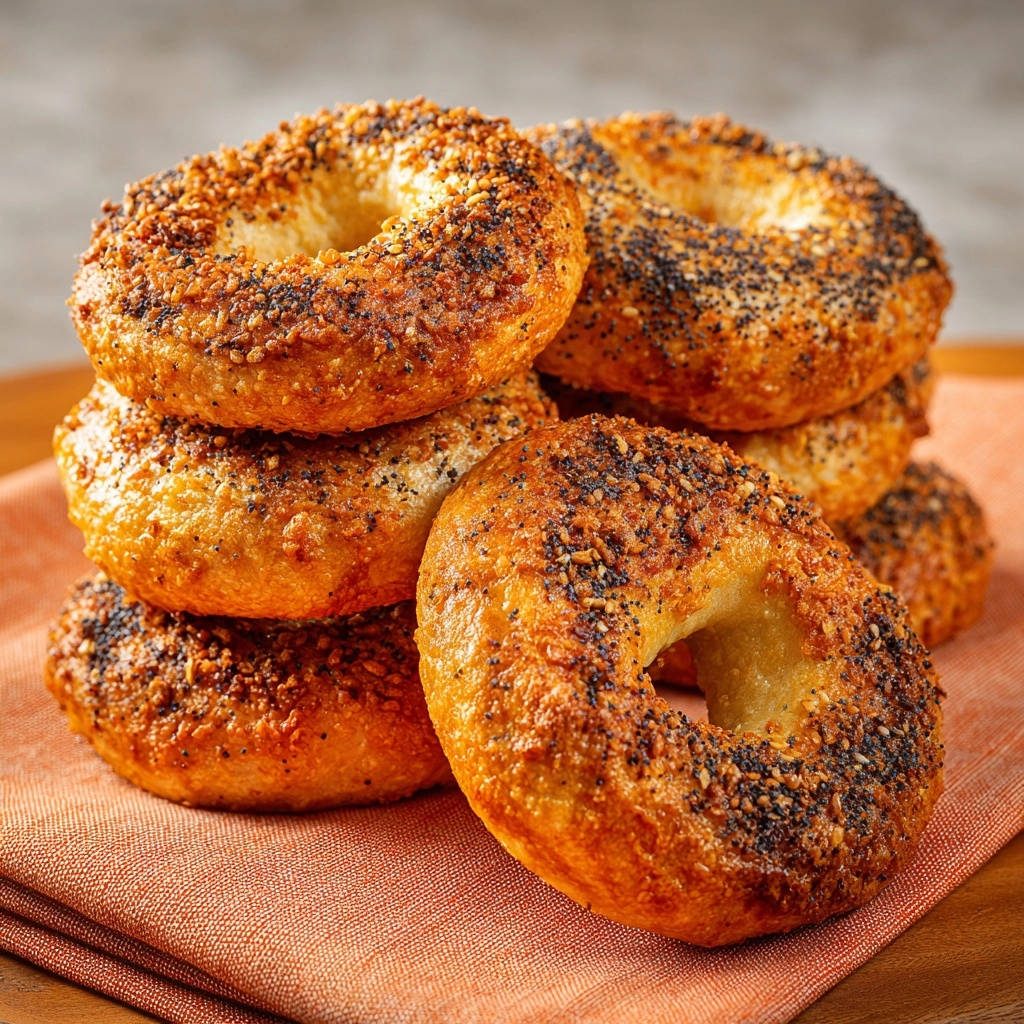Biting into a homemade bagel only to watch the delicious ‘everything’ seasoning flake onto your plate is one of the kitchen’s great frustrations.
After years of experimentation, I have cracked the code: a simple, non-negotiable post-boil technique that guarantees zero fallout and maximum crunch, delivering truly Ultimate Everything Bagels every time.
The Ultimate Everything Bagels Recipe That Actually Sticks (And Why)
This recipe transforms the standard bagel process into a reliable method for professional-quality results, emphasizing structure and maximum flavor adhesion.
The Zero-Fallout Promise: Guaranteed Seasoning Adhesion
The secret lies in applying a high-protein egg white wash immediately after the quick alkaline boil.
This targets the still-tacky, gelatinized starch crust, creating an industrial-strength binder that permanently locks the seasoning blend onto the bagel surface through the baking process, ensuring maximum flavor retention.
The Power of High-Protein Flour for Superior Chew
The characteristic dense, chewy texture of a perfect bagel is entirely dependent on high-protein bread flour.
This flour develops strong gluten strands necessary to withstand the intense kneading and boiling process, achieving the desired, resilient crumb structure.
The Importance of the Chill: Enhanced Flavor and Handling
The mandatory cold proof (chilling) slows fermentation, allowing complex flavor compounds to develop over time, which significantly enhances the overall flavor profile.
Furthermore, chilling stiffens the dough, stabilizing the shaped rings and making them much easier to handle when transferring them into the boiling water bath.
Equipping Your Kitchen: Essential Bagel-Making Tools
While bagels can be made by hand, certain tools simplify the process, especially when dealing with the stiff dough required for the best texture.
Stand Mixer with Dough Hook (Optional but Recommended): For efficient kneading of the stiff dough.
Wide, Shallow Boiling Pot: Essential for safe and easy handling during the boiling stage, allowing bagels to float freely.
Slotted Spoon or Spider Strainer: For removing the boiled bagels without tearing or splashing.
Wire Cooling Rack: Needed for draining after the boil and subsequently cooling after the bake, preventing a soggy bottom.
Building the Perfect Ultimate Everything Bagels: Ingredient Roles
Activating the Yeast: Temperature Matters
Active dry yeast requires warm water, ideally between 105°F and 115°F, to hydrate and become fully active without being killed by excessive heat.
The addition of brown sugar or honey provides instant fuel, ensuring a strong, visible foam that confirms your yeast is viable and ready to leaven the dough.
High-Protein Bread Flour vs. All-Purpose
Bread flour contains significantly more protein (12-14%) than standard all-purpose flour, making it crucial for developing the robust gluten matrix needed for that signature chewy bite.
Substituting with all-purpose flour will inevitably result in a softer, more bread-like texture lacking the desirable density and chewiness.
The Crucial Baking Soda Bath
Adding baking soda to the boiling water raises the alkalinity, which immediately gelatinizes the exterior starch of the dough.
This chemical reaction creates a thin, protective skin that locks in moisture during baking, resulting in the desired crisp, glossy, and deeply colored crust.
The Everything Bagel Seasoning Blend
A quality blend typically contains a mix of poppy seeds, black and white sesame seeds, dried minced garlic, dried minced onion, and coarse sea salt.
Ensure you have a generous half cup on hand to coat the entire batch liberally-we aim for maximum, wall-to-wall flavor coverage that stays adhered.
Mastering the Ultimate Everything Bagels Method (The Step-by-Step Guide)
Follow these steps closely, paying special attention to timing and handling, to ensure success with your homemade Ultimate Everything Bagels.
- Make the Dough and Proof the Yeast:
Combine warm water, yeast, and sugar, and allow the mixture to foam visibly for 5-7 minutes before adding your bread flour and salt.
This confirmation step ensures your yeast is viable, preventing the failure of the first rise.
- Kneading for Structure: The Stiff Dough Requirement:
This dough is intentionally stiff; it must be kneaded for the full time (8-10 mins by machine, 12-15 mins by hand) to develop strong gluten structure.
Stop when the dough is smooth, elastic, and resists tearing, indicating perfect readiness for the first rise.
- First Rise and Gentle Punch Down:
Allow the dough to double in size, typically 60-90 minutes, ensuring the environment is consistently warm.
When punching down, handle the dough gently to release built-up gas without completely collapsing the established structure.
- Achieving the Perfect Bagel Shape (The Finger Hole Technique):
After dividing into 8 equal pieces, roll smooth balls. Use a floured finger to poke the hole, then gently stretch the ring to achieve an opening approximately 1 inch wide.
This wide initial hole is critical, as it prevents the ring from closing up entirely during the subsequent boiling and baking stages.
- The Chill Factor: Overnight or Minimum One Hour:
This cold proof stabilizes the shape and significantly deepens the flavor through slow, beneficial fermentation.
The chilled dough handles better during the boiling transfer and produces the characteristic texture of a true artisan bagel.
The Crucial Step: Locking In Flavor with the Everything Bagel Adhesion Technique
Precise Timing for the Alkaline Boil
Preheat your oven to 425°F while bringing the baking soda water to a rolling boil.
Drop 2 or 3 chilled bagels into the water-never crowd the pot-and boil for exactly 60 seconds per side, flipping carefully halfway through.
Boiling longer than 90 seconds per side will result in a much thicker, chewier, and potentially rubbery crust.
Why the Post-Boil Egg Wash is the Secret Weapon
The adhesion wash is made simply from one large egg white beaten lightly with a tablespoon of cold water until slightly foamy.
Immediately upon removing the bagel from the boil, place it on a wire rack for only a few seconds to drain excess water, then instantly brush the entire surface liberally with the wash.
The protein in the egg white adheres instantly to the warm, tacky, gelatinized crust, creating the necessary binder before the crust dries out.
Seasoning Adhesion: Immediate Application is Key
There is zero lag time here: the moment the egg wash is applied, press the bagel directly into the bowl of everything seasoning blend.
Ensure the sides and top are fully submerged and covered; this step guarantees a perfectly crusted bagel with zero fallout after baking.
Troubleshooting Your Bake: Ensuring Your Bagels Rise, Shine, and Crisp
Problem: My Dough Didn’t Rise or My Bagels Are Flat
Check your water temperature: if it was above 120°F, you likely killed the active dry yeast, preventing any rise.
Always use fresh yeast and ensure the rising location is sufficiently warm; cold temperatures significantly slow down the fermentation process needed for volume.
Problem: The Bagels Are Too Dense and Cake-Like
Density often indicates insufficient kneading, which failed to develop adequate gluten structure to support the rise.
Alternatively, over-boiling can create too thick a gelatinized crust, trapping moisture and resulting in a heavy, undercooked interior.
Problem: My Everything Seasoning Still Fell Off
This means you waited too long after the boil; the tacky surface must be sealed with the egg wash immediately, while it is still warm and damp.
Do not place the boiled bagels on paper towels or allow them to cool even briefly before applying the wash and seasoning.
Serving, Storing, and Freezing Your Ultimate Everything Bagels
How to Achieve the Perfect Slice
Always wait until the bagels are completely cool before attempting to slice them, otherwise, you risk crushing the interior crumb and tearing the crust.
Use a sturdy, sharp serrated knife and a gentle back-and-forth motion to cleanly cut through the dense exterior.
Optimal Storage Practices
Homemade bagels lack the preservatives of commercial versions and are best enjoyed within two days when stored at room temperature in a sealed paper or plastic bag.
For preservation longer than 48 hours, freezing is strongly recommended, as refrigeration rapidly stales the texture of bread products.
The Best Way to Freeze and Reheat for Freshness
Slice all of your Ultimate Everything Bagels completely before freezing them in a heavy-duty, zip-top freezer bag, ensuring as much air is removed as possible.
To reheat, toast the slices directly from frozen until warm and crisp, or mist them lightly with water and bake in a 350°F oven for 5 minutes.
FAQs About Baking Ultimate Everything Bagels at Home
Can I Substitute Active Dry Yeast for Instant Yeast?
Yes, you can substitute instant yeast 1:1 for active dry yeast. You may add the instant yeast directly to the dry ingredients if you are confident in its freshness.
However, allowing it to proof with the sugar and water still serves as a necessary quality control check for perfect results.
Is Bread Flour Truly Necessary for This Recipe?
Yes, bread flour is essential. Its high-protein content creates the strong, dense gluten network required to give the bagels their characteristic chew.
Using standard all-purpose flour will lead to a weaker dough structure and a softer, less satisfying, bread-roll texture.
Can I Skip the Boiling Step?
No, skipping the boil means you skip the alkaline gelatinization step, resulting in zero gloss and a dough structure that expands excessively during baking.
The boiling bath is critical for controlling expansion, forming the crust, and achieving the signature sheen on the finished bagel.
How Long Do Homemade Bagels Stay Fresh?
For peak flavor and ideal soft-chewy texture, homemade bagels maintain their quality for about two days at room temperature.
They remain edible for up to four or five days, but they will require toasting to restore texture after the second day.
Ready to Impress? Share Your Ultimate Everything Bagels Masterpiece!
The difference between a good homemade bagel and a truly great one comes down entirely to attention to detail in the two critical steps: proper stiff kneading and the post-boil adhesion technique.
Now that you have the expertise and the exact method, ditch the store-bought versions and make a batch of these glorious Ultimate Everything Bagels.
I guarantee your friends will be asking which local artisan bakery you visited. Tag us and let me know how your zero-fallout bake turns out!
Ultimate Everything Bagels
Course: BreadCuisine: American CuisineDifficulty: easy8
Bagels2
hours18
minutes120
minutesAmerican Cuisine
Ingredients
1 tablespoon active dry yeast
1 1/2 cups warm water (about 105 degrees F)
1 tablespoon brown sugar or honey
3 1/2 cups high-protein bread flour (plus more for dusting)
1 teaspoon fine sea salt
2 quarts water (for boiling)
2 tablespoons baking soda (for boiling water)
1 large egg white (for binding wash)
1 tablespoon cold water (for binding wash)
1/2 cup Everything Bagel seasoning blend
Directions
- Make the Dough: In the bowl of a stand mixer or a large bowl, combine the warm water, yeast, and brown sugar. Let stand until foamy, about 5 to 7 minutes. Add the bread flour and salt.
- Knead: Knead the dough using a dough hook attachment on medium-low speed for 8 to 10 minutes until the dough is smooth, stiff, and elastic. If kneading by hand, use a sturdy surface and knead vigorously for 12 to 15 minutes.
- First Rise: Form the dough into a ball and place it in a lightly oiled bowl. Cover and let rise in a warm place until doubled, about 60 to 90 minutes.
- Shape and Chill: Punch down the dough gently. Divide the dough into 8 equal pieces. Roll each piece into a smooth ball. Using a floured finger, poke a hole through the center of each ball and gently stretch it to form a ring about 1 inch wide. Place the shaped bagels on a lightly floured baking sheet, cover loosely, and chill in the refrigerator for at least 1 hour (this cooling step greatly improves flavor and texture).
- Prepare for Boiling: Preheat your oven to 425 degrees F. Bring the 2 quarts of water and the baking soda to a rolling boil in a wide, shallow pot. Whisk the egg white with 1 tablespoon of cold water in a small bowl to create the binding wash.
- The Boiling Lock-In Technique: Drop 2 or 3 bagels into the boiling water mixture (do not crowd the pot). Boil for 60 seconds, then flip the bagels and boil for another 60 seconds. Remove immediately with a slotted spoon and place the wet bagels directly onto a wire rack to drain excess water for only a few seconds.
- Seasoning Adhesion: THIS IS THE CRUCIAL STEP. While the boiled bagel is still warm and slightly tacky, immediately brush the entire surface (top and sides) liberally with the egg white wash. This protein binder will adhere to the boiled, tacky crust. Immediately press the egg-washed side into the Everything Bagel seasoning, ensuring full coverage. Place the coated bagel onto a baking sheet lined with parchment paper or a silicone mat. Repeat with the remaining bagels.
- Bake: Bake the bagels for 15 to 18 minutes, or until deeply golden brown and the seasoning crust is crisp and set. Cool completely on a wire rack before slicing and serving.
Notes
- The binding wash applied immediately after boiling is crucial for seasoning adhesion.





